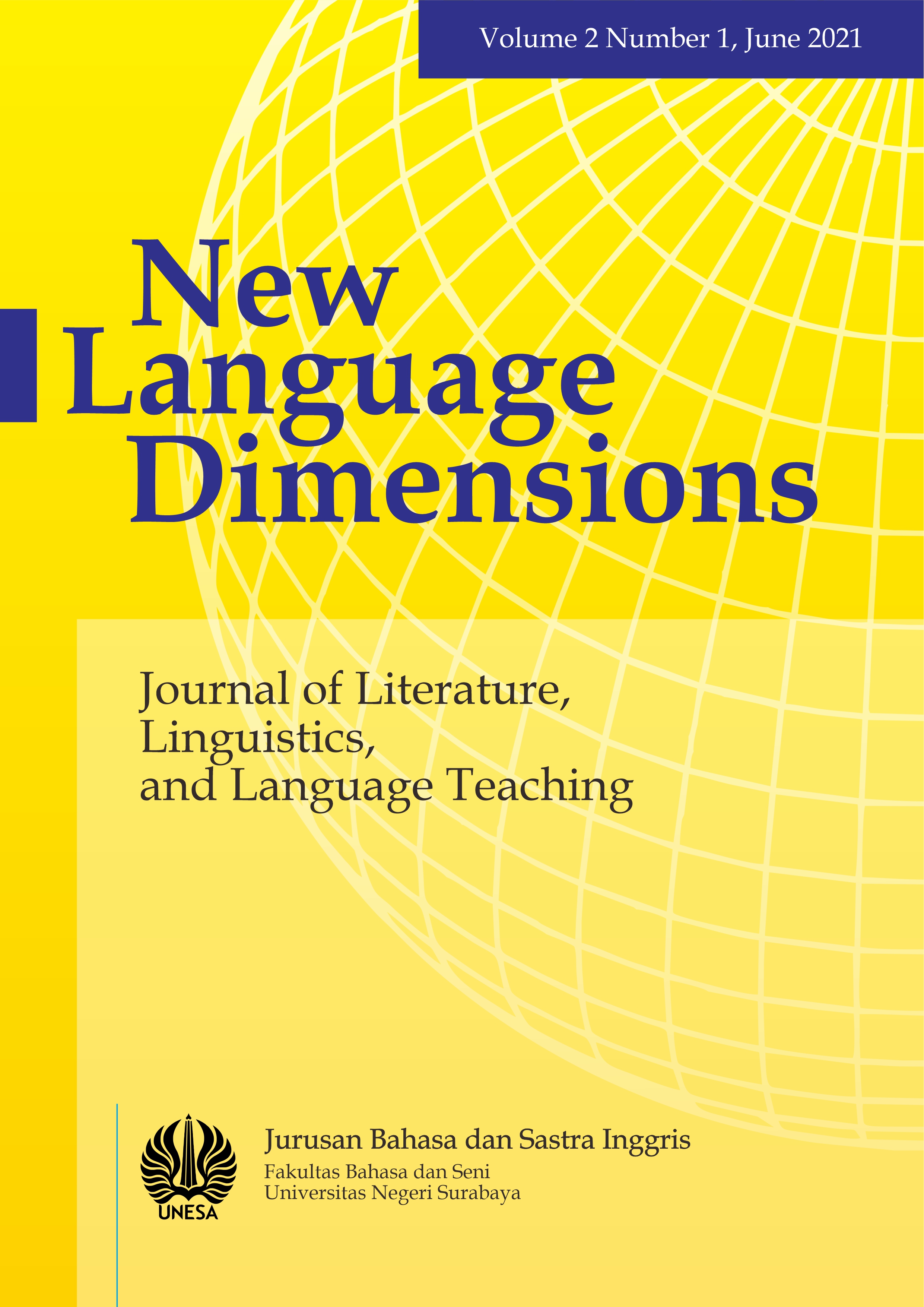Students Perceptions towards Distance Learning with Online Collaborative Platforms: A Case Study
DOI:
https://doi.org/10.26740/nld.v2n1.p1-14Abstract
In view of the COVID-19 pandemic and government policy to carry out distance education by employing full online learning. The research explores the EFL students perception toward distance education during Covid19 Pandemic with online collaborative platforms which employed in EFL Students of English Department of a private college in Indonesia. This research used a descriptive case research using purposive sampling techniques by taking 27 respondents from English Department at STKIP PGRI Jombang. The online questionnaire used to collect data on the perception of students by employing online collaborative platforms. The questionnaire are adapted from the technology acceptance model (TAM) constructed by Davis, 1989 with little modification as it excludes the external factors such as the availability of the internet access, and the support from the administration. TAM is possibly the most widely-used framework for measuring technology acceptance, and its high validity has been proven empirically in many previous studies (Basri & Paramma, 2019 and Wiyaka et.al., 2018). The quantitative data was collected using an online questionnaire posted in Google form. The method of descriptive case research in terms of percentage has been used for data processing. The result of this research indicates the positive perception those EFL students of English Department at STKIP PGRI Jombang who took Critical Reading by using online collaborative platforms held on the use of online collaborative platforms. Further research can refer to this Acceptance Model in determining a suitable ICT integrated learning program betien various platform and the user expectations of the online platforms used.Downloads
Download data is not yet available.
References
<p>Azhar, K.A. (2018). Effectiveness of Google Classroom: Teachers perception.</p><p><em>Prizren Social ScienceJournal</em>, vol.2, no. 2, pp. 52-66.</p><p>Ajzen, I., & Fishbein, M. (2000). Attitudes and the Attitude-Behavior Relation:</p><p>Reasoned and Automatic Processes. <em>European Review of Social Psychology</em>, <em>11</em>(1), 133. Retrieved from <a href="http://www.tandfonline.com/doi/abs/10.1080/14792779943000116">http://www.tandfonline.com/doi/abs/10.1080/14792779943000116</a></p><p>Abdulah,R.,N., Muait.,J.A. &Ganefri.(2019).Students perception towards modern</p><p>technology as teaching Aids.<em>Asian Journal of Assessment in Teaching and </em></p><p><em>Learning</em>, Vol. 9,(2)<a href="http://doi.org/10.37134/ajatel.vol9.no2.5.2019">http://doi.org/10.37134/ajatel.vol9.no2.5.2019</a></p><p>Abbasi, M., &Behjat, F. (2016). The effect of storytelling on Iranian EFL learners</p><p>speaking complexity. <em>Studiesin English Language Teaching, 4</em>(4), 416.</p><p><a href="https://doi.org/10.22158/selt.v4n4p416">https://doi.org/10.22158/selt.v4n4p416</a></p><p>Ahn, S. K. (2018). <em>Korean EFL college students acceptance and use of smartphone </em></p><p><em>applications for Englishlanguage learning</em>. ProQuest.<em></em></p><p>Beatty, K.(2017).<em>Teaching and Learning Computer Assisted Language Learning</em>,(2<sup>nd</sup></p><p>Ed.)London:Pearson Education Limited.</p><p class="Default">Basri, M.,& Paramma, M.A.(2019). EFL students perspective on the usefulness of</p><p class="Default">ICT based learning in Indonesian higher education. <em>ELT Worldwide Journa, </em>Vol.6.</p><p>Cakrawati.L.,M. (2017) Students' perceptions on the use of online learning platforms</p><p>In EFL classroom.<em>Journals English Language Teaching and Technology Journal</em>, Vol1<a href="http://ejournal.upi.edu/index.php/ELTTech/article/view/9428">http://ejournal.upi.edu/index.php/ELTTech/article/view/9428</a></p><p>Creswell, J.W. (2012) <em>Educational research: planning, conducting, and evaluating </em></p><p><em>quantitative and qualitative research. </em>Boston: Pearson Education, Inc.</p><p>Chapelle,C.A.(2003).<em>Computer Application in Second Language Acquisition.</em></p><p>Cambridge: Cambridge University Press.</p><p>Dewanti,A.(2018).<em>The effect of teaching reading using Hot Potatoes ib based </em></p><p><em>exercise in high school students reading comprehension</em>.(Unpublished Thesis):, Universitas Sanata Dharma Jogjakarta .</p><p><cite>Davis, B., Carmean, C., & Wagner, E. (2009).The Evolution of the LMS¯: From </cite></p><p><cite>Management to Learning". The ELearning Guide Research.</cite></p><p>Cao, W., Fang, Z., Hou, G., Han, M., Xu, X., Dong, J., & Zheng, J. (2020).The</p><p>Psychological Impact of the COVID-19 Epidemic on Colleg Students in China. <em>Psychiatry Research</em>, <em>287</em>, 15. https://doi.org/10.1016/j.psychres.2020.112934</p><p>Ellis, R.; Calvo, R.A. (2007). Minimum indicators to quality assure blended learning</p><p>supported by learning management system .<em>Journal of Educational Technology Society</em>, Vol 5 (2).</p><p>Elliot, Stephen et al. 2000. <em>Educational psychology: Effective teaching and learning</em>.</p><p>United States: The McGraw-Hill Companies, Inc.</p><p>Harjanto, A.,S. &Sumarni. S.( 2019). <em>Teachers experiences on the use of Google </em></p><p><em>Classroomproceedings</em>.3rd English Language and Literature International Conference (ELLiC),Vol. 3(2).</p><p>Harasim, L. (2012). Learning theory and online technologies. New York, NY: Routledge.</p><p>Iftakhar, S. (2016). Google Classroom: What works and how? <em>Journal of Education </em></p><p><em>and Social Sciences</em>, vol.3, pp. 12-18.</p><p>Ghobadi, S., &Taki, S. (2018). Effects of Telegram stickers on English vocabulary</p><p>learning: focus on IranianEFL learners. <em>Research in English Language Pedagogy, 6</em>(1), 139158.</p><p>Gregorc, Anthony. (2001). <em>Introduction to perception</em>. United States: The McGraw-Hill</p><p>Companies, Inc.</p><p>Khalil, M., Z.(2018) EFL students perceptions towards using Google docs and</p><p>Google Classroom as online collaborative Tools in LearningGrammar.<em>Applied Linguistics Research Journal (ALR Journal)</em>.Vol.2 (2).<a href="http://doi.org/10.14744/alrj.2018.47955">http://doi.org/10.14744/alrj.2018.47955</a></p><p>Keeler, A. & Miller, L. (2016).<em>50 you can do with Google Classroom</em>. SanDiego</p><p>California: Dave BurgessConsulting Inc.</p><p>Kilichaya &Supprananto.(2013). The impact of CALL instruction on English</p><p>language teachers use technology of IT. <em>Second and Multiple Language </em></p><p><em>Acquisition Journal,</em>Vol.1(2).</p><p><cite>Long, Phillip D. (2004)</cite><cite>. Learning Management Systems (LMS). Thousand Oaks: </cite><cite></cite></p><p><cite>SAGE Publications, Inc. http://doi.org/</cite><a href="https://doi.org/10.4135%2F9781412950596.n99">10.4135/9781412950596.n99</a><cite></cite></p><p>Licorishet al.(2018). Students perception of Kahoot!s influence on teaching and</p><p>learning.<em>Research and Practice in Technology Enhanced Learning Journal</em>,</p><p>Vol. 13(9).<a href="https://doi.org/10.1186/s41039-018-0078-8">https://doi.org/10.1186/s41039-018-0078-8</a></p><p>Mafa, K.R. (2018). Capabilities of Google Classroom as a teaching and learning tool</p><p>in higher. education. International Journal of Science Technology</p><p>&Engineering, vol. 5, no. 5, pp. 30-34.</p><p>Manalu, B.,H.(2019)Students Perception of digital texts Reading: A case research at the</p><p>English Education Department of Universitas Kristen Indonesia.<em>Journal of </em></p><p><em>English Teaching</em>, Vol. 5(3).<a href="http://doi.org/10.33541/jet.v5i3.1312">http://doi.org/10.33541/jet.v5i3.1312</a></p><p>Manawong,S.(2016).Undergraduate students perception of Edmodo as a</p><p>supplementary learning tool in an EFL classroom. Silpakorn University Journal of Social Science, Humanities and Art, 16(2).<a href="https://doi.org/10.14456/sujsha.2016.27">https://doi.org/10.14456/sujsha.2016.27 </a></p><p>Mendikbud. (2020a). <em>Surat Edaran Mendikbud: Pelaksanaan Kebijakan Pendidikan dalam </em></p><p><em>Masa Darurat Penyebaran Corona Virus Disease(COVID-19)</em>.</p><p>Retrieved from <a href="http://kemdikbud.go.id/main/files/download/51e9b72ef92c6d8">http://kemdikbud.go.id/main/files/download/51e9b72ef92c6d8</a></p><p>Mendikbud. (2020b). <em>Surat Edaran Mendikbud: Pembelajaran secara Daring dan Bekerja </em></p><p><em>dari Rumah dalam Rangka Pencegahan Penyebaran Corona Virus Disease (COVID-19)</em>. Retrieved from<em> </em><a href="http://kemdikbud.go.id/main/files/download/c5d9f0ec9ff40c6">http://kemdikbud.go.id/main/files/download/c5d9f0ec9ff40c6</a></p><p>Moorhouse, B. L. (2020). Adaptations to a Face-to-Face Initial Teacher Education Course</p><p>˜Forced Online due to the COVID-19 Pandemic. <em>Journal of Education for Teaching</em>.</p><p><a href="https://doi.org/10.1080/02607476.2020.1755205">https://doi.org/10.1080/02607476.2020.1755205</a></p><p>Moore, M., & Kearsley, G. (2005<em>). Distance Education: A systems view of online learning</em>.</p><p>Belmont, CA. Wadsworth, Cengage Learning</p><p>Nasrollahi, Mohammad Ali, et al. (2015). Identifying the Critical Reading Strategies</p><p>Employed By Iranian EFL Learners.<em>International J. Soc. Sci. & Education </em>Vol.5 Issue 2, ISSN:2223-4934 E and 2227-393X Print.</p><p>Suratno,A.&Aydawati, E.,N.(2016).Exploring students perception and ICT use in</p><p>Indonesian High Schools.<em>A Journal of Culture, English Language, Teaching &Literature,</em>Vol.16(2).</p><p>Sapitri, R & Amin S.T ( 2018).Students Critical Thingking Skills As Reflected On</p><p>Their IeltsReading Test: Case Research At University of Muslim Nusantara Al-Wasliyah. <em>English Language Teaching And Research Journal, </em>Volume 2(1)</p><p>Wallace, C. (2003). <em>Critical reading in language education</em>. (pp. 312-315). Palgrave</p><p>Macmillan.</p><p>Wang, AI. (2015). The iar out effect of a game-based student response system.</p><p>Computers &Education</p><p>Wiyaka, Mujiyanto, J., & Rukmini, D. (2018). Students Perception on the</p><p>Usefulness of ICT-Based Language Program. <em>English Language Teaching</em>, <em>11</em>(2), 53. Retrieved from <a href="http://www.ccsenet.org/journal/index.php/elt/article/view/72882">http://www.ccsenet.org/journal/index.php/elt/article/view/72882</a></p><p>Yin, R. (2003). Case research research: Design and methods. Thousand Oaks, CA: Sage</p><p>Publications.</p><p>Yin, R ( 2014).Case research research: Design and methods. Thousand Oaks, CA: Sage</p><p>Publications.</p><p>Yinka, A. R., &Queendarline, N. N. (2018). Telegram as a social media tool for</p><p>teaching and learning in tertiaryinstitutions. <em>International Journal of Multidisciplinary Research and Development, 5</em>(7), 9598.</p><p>Sun, S. Y. H. (2014). Learner Perspectives on Fully Online Language Learning. <em>Distance </em></p><p><em>Education</em>, <em>35</em>(1), 1842. <a href="https://doi.org/10.1080/01587919.2014.891428">https://doi.org/10.1080/01587919.2014.891428</a></p>
Downloads
Additional Files
Published
2021-07-12
Issue
Section
Articles
 Abstract views: 4889
,
Abstract views: 4889
, PDF Downloads: 708
,
PDF Downloads: 708
, PDF Downloads: 0
PDF Downloads: 0











